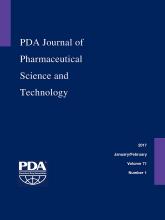Research ArticleTechnology/Application
Development of Conductivity Method as an Alternative to Titration for Hydrolytic Resistance Testing Used for Evaluation of Glass Vials Used in Pharmaceutical Industry
Kiyoshi Fujimori, Hans Lee, Joseph Phillips and Yasser Nashed-Samuel
PDA Journal of Pharmaceutical Science and Technology January 2017, 71 (1) 50-58; DOI: https://doi.org/10.5731/pdajpst.2016.007005
Kiyoshi Fujimori
Amgen Inc., Drug Product Development, Thousand Oaks, CA, USA
Hans Lee
Amgen Inc., Drug Product Development, Thousand Oaks, CA, USA
Joseph Phillips
Amgen Inc., Drug Product Development, Thousand Oaks, CA, USA
Yasser Nashed-Samuel
Amgen Inc., Drug Product Development, Thousand Oaks, CA, USA

References
- 1.↵
- Scholze H.
- 2.↵
- 3.↵
- Tian L.,
- Dieckmann R.,
- Hui C.-Y.,
- Lin Y.-Y.,
- Couillard J. G.
- 4.↵
- 5.↵
- Iacocca R. G.,
- Allgeier M.
- 6.↵
- Iacocca R. G.
- 7.↵
- Yamanaka S.,
- Akaji J.,
- Hattori M.
- 8.↵
- Bohrer D.,
- Bortoluzzi F.,
- Nascimento P. C.,
- Carvalho L. M.,
- Ramirez A. G.
- 9.↵
- Bacon F. R.,
- Raggon F. C.
- 10.↵
- Guadagnino E.,
- Zuccato D.
- 11.↵
- Jiang G.,
- Goss M.,
- Li G.,
- Jing W.,
- Shen H.,
- Fujimori K.,
- Le L.,
- Wong L.,
- Wen Z.,
- Nashed-Samuel Y.,
- Riker K.,
- Germansderfer A.,
- Tsang P.,
- Ricci M.
- 12.↵U.S. Food and Drug Administration. Safety Reports for Human Medical Products: Epoetin alfa (2010), Hyaluronidase Recombinant (2010), and Methotrexate (2013).
- 13.↵Chapter 3.2.1. Glass Containers for Pharmaceutical Use. In European Pharmacopoeia, 7th ed.; Council of Europe: Strasbourg, France, 2011.
- 14.↵General Chapter <660> Containers—Glass. In United States Pharmacopeia 35–National Formulary 30; U.S. Pharmacopeial Convention: Rockville, MD, 2012.
- 15.↵U.S. Food and Drug Administration (FDA). Guidance for Industry—Q2B Validation of Analytical Procedures: Methodology. FDA: Rockville, MD, 1996.
In This Issue
PDA Journal of Pharmaceutical Science and Technology
Vol. 71, Issue 1
January/February 2017
Development of Conductivity Method as an Alternative to Titration for Hydrolytic Resistance Testing Used for Evaluation of Glass Vials Used in Pharmaceutical Industry
Kiyoshi Fujimori, Hans Lee, Joseph Phillips, Yasser Nashed-Samuel
PDA Journal of Pharmaceutical Science and Technology Jan 2017, 71 (1) 50-58; DOI: 10.5731/pdajpst.2016.007005
Development of Conductivity Method as an Alternative to Titration for Hydrolytic Resistance Testing Used for Evaluation of Glass Vials Used in Pharmaceutical Industry
Kiyoshi Fujimori, Hans Lee, Joseph Phillips, Yasser Nashed-Samuel
PDA Journal of Pharmaceutical Science and Technology Jan 2017, 71 (1) 50-58; DOI: 10.5731/pdajpst.2016.007005
Jump to section
Related Articles
- No related articles found.





